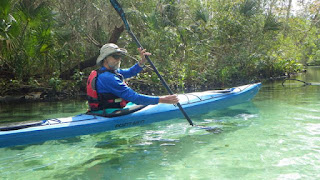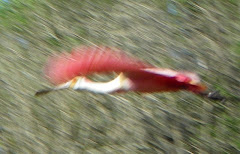For many of us, after the calm of summer come autumn winds,
and with the winds, rougher conditions along the coast. This is a time when
it’s good to remember that hand in hand with the tumbling surf comes
the danger of undertow and rip currents that pull away from shore.
 |
| Powerful shore-break on Brighton beach can create undertow |
Rips are formed by surf when white water tumbles down the face of breaking waves toward shore. That water then escapes along the beach to a deeper channel cutting out to sea through the surf line as a rip current. Beyond the break line, the current dissipates. Rip currents are relatively narrow and focused currents, that can flow much faster than a swimmer can swim. The water carried to shore by the surf will drain along the beach until it reaches a rip. You can often feel the sideways pull of this alongshore current against your ankles in shallow water, and by walking downstream locate the rip. If you pass the rip, you’ll feel the water flowing in the opposite direction.
 |
| Arrows show rip current. Look for breaks in the lines of surf and also moving water |
Viewed from shore, the rip will appear as moving water with
more confused wave patterns than the surf on either side, and with smaller
waves. The scouring effect of the current gouges out a deeper channel. As the
waves push in and slow against the current, they converge and crisscross and
run off to either side, leaving a visibly calmer channel. Rips are most easily
seen from elevation. Once you have located a rip, look for landmarks that will
help you locate it from the water.
If caught in a rip, escape by swimming across the current.
Once you are out of the current the surf will help push you toward shore
again. You’ll be quickly exhausted if you try to swim to shore against the rip
current and if If you do nothing, you’ll be carried beyond the surf, so swim across
the current.
Launching through surf to sea kayak, or to go surfing, the
rip can offer an easy way through the break. (You can also read more in my book The Art of Kayaking).In a rip the waves are smaller and
more broken, and the current will help carry you from shore. The danger is that
once you’ve been carried out, you’ll find the conditions more than you
bargained for, and have difficulty returning to shore.
 |
| A rip can easily help carry you out farther than you might want |
So, although paddling out against the surf can be
exhausting, it’s best to locate and then avoid the rips to start with, at least
you know how big and powerful the waves really are today. When battling through
waves from the beach between rips, you can easily turn back when you choose,
before you meet the biggest waves. If you find yourself beyond the break,
waiting for a big set to ride the biggest waves, and you are comfortable with the
conditions, then you might consider using a rip to make your paddling out
easier.
A rip is not the same thing as undertow, although you’ll
often find the terms misapplied. Undertow is caused by shore-breaks, rips are
caused by surf. But the two sometimes work together when there is both surf and
a powerful shore-break. Undertow is caused by the backwash returning down the
beach after a wave has broken. In certain wave conditions beach cusps form as a
series of scooped out hollows separated by spurs pointing seaward. Each beach
cusp focuses the power of the shore-break into a tongue of water rushing up the
beach which drains back into a narrow channel of rapid water often powerful
enough to sweep a person from their feet. This focused backwash drags through
the next breaking wave, so it can carry an unwary person beyond the shore-break
into deep water.
Returning safely to the beach might require outside
assistance: for example, a throw-line.
 |
| Beach cusps funnel backwash into jets that push out to sea as undertow |
When a beach has both a sizable shore-break, and lines of
breaking surf, you can find both undertow at the shore, and rips running out
through the lines of surf. The undertow can feed a swimmer into current that
runs into a rip. The rip can deliver the swimmer beyond the break into ocean
current. People swept from a beach by undertow don’t always return.
Rips and Undertow are beach hazards. The Rips and Undertow Video Presentation
takes about ten minutes and shows more clearly what is going on. If you find it
useful, please spread the word, and be safe!






































